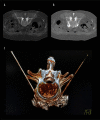Lumbar Sympathetic Nerve Modulation Using Absolute Ethanol for the Treatment of Primary Lower-Extremity Hyperhidrosis: A Dose-Effect Pilot Study
- PMID: 33434188
- PMCID: PMC7812694
- DOI: 10.12659/MSM.928209
Lumbar Sympathetic Nerve Modulation Using Absolute Ethanol for the Treatment of Primary Lower-Extremity Hyperhidrosis: A Dose-Effect Pilot Study
Abstract
BACKGROUND Primary lower-extremity hyperhidrosis (PLEH) can be treated by CT-guided lumbar sympathetic nerve modulation using absolute ethanol. However, doses of ethanol that are too high can cause nerve injury, and doses that are too low have suboptimal results. The present study aimed to investigate the dose-effect relationship of CT-guided lumbar sympathetic nerve modulation with absolute ethanol for PLEH. MATERIAL AND METHODS The study was conducted at the First Affiliated Hospital of Jiaxing University between 07/2014 and 02/2017. Twenty participants were enrolled in each group. The doses of absolute ethanol were 2.0 ml in the R₁ group, 2.5 ml in the R₂ group, 3.0 ml in the R₃ group, 3.5 ml in the R₄ group, and 4.0 ml in the R₅ group. Treatment effectiveness was assessed according to the time to complete hyperhidrosis relief: <10 min, effective; ≥10 min, non-effective. RESULTS The patient characteristics among the 5 groups were not statistically different (P>0.05). The onset time and time to complete hyperhidrosis relief decreased significantly with increasing dose of absolute ethanol (P<0.05). The effective rates in the 5 groups were 15.0%, 35.0%, 60.0%, 90.0%, and 100.0%, respectively. The ED₅₀ and ED₉₅ were 2.306 ml (95% CI: 2.003-2.512 ml) and 3.343 ml (95% CI: 3.051-3.962 ml), respectively. CONCLUSIONS This was the first dose-effect pilot study of consecutive PLEH patients treated by CT-guided lumbar sympathetic nerve modulation. CT-guided lumbar sympathetic nerve modulation with 2.306 ml (ED₅₀) and 3.343 ml (ED₉₅) of absolute ethanol showed treatment efficacy for PLEH. No complications were seen.
Conflict of interest statement
None.
Figures

Similar articles
-
[Therapeutic feasibility of percutaneous puncture and chemical neurolysis of thoracic sympathetic nerve block in palmar hyperhidrosis under the guidance of computed tomograph].Zhonghua Yi Xue Za Zhi. 2011 Oct 18;91(38):2710-3. Zhonghua Yi Xue Za Zhi. 2011. PMID: 22321983 Chinese.
-
Percutaneous lumbar sympathetic plexus catheter placement for short- and long-term pain relief: CT technique and results.J Comput Assist Tomogr. 1998 Jul-Aug;22(4):518-23. doi: 10.1097/00004728-199807000-00003. J Comput Assist Tomogr. 1998. PMID: 9676438
-
Oximetry-derived perfusion index as an early indicator of CT-guided thoracic sympathetic blockade in palmar hyperhidrosis.Clin Radiol. 2013 Dec;68(12):1227-32. doi: 10.1016/j.crad.2013.07.003. Epub 2013 Aug 19. Clin Radiol. 2013. PMID: 23969155 Clinical Trial.
-
Sympathetic blockade for the relief of chronic pain.J Indian Med Assoc. 2001 Dec;99(12):698-703. J Indian Med Assoc. 2001. PMID: 12022220 Review.
-
Lumbar sympathetic treatment in the management of lower limb pain.Curr Pain Headache Rep. 2014 Apr;18(4):403. doi: 10.1007/s11916-014-0403-x. Curr Pain Headache Rep. 2014. PMID: 24643353 Review.
Cited by
-
Agents Used for Nerve Blocks and Neurolysis.Semin Intervent Radiol. 2022 Nov 17;39(4):387-393. doi: 10.1055/s-0042-1757315. eCollection 2022 Aug. Semin Intervent Radiol. 2022. PMID: 36406019 Free PMC article. Review.
-
Computed tomography-guided chemical renal sympathetic nerve modulation in the treatment of resistant hypertension: A case report.World J Clin Cases. 2021 Nov 16;9(32):9970-9976. doi: 10.12998/wjcc.v9.i32.9970. World J Clin Cases. 2021. PMID: 34877338 Free PMC article.
-
Comparison of CT-guided thoracic sympathetic nerve block and radiofrequency in the treatment of primary palmar hyperhidrosis.Front Surg. 2023 May 31;10:1126596. doi: 10.3389/fsurg.2023.1126596. eCollection 2023. Front Surg. 2023. PMID: 37325414 Free PMC article.
References
-
- Eisenach JH, Atkinson JL, Fealey RD. Hyperhidrosis: Evolving therapies for a well-established phenomenon. Mayo Clin Proc. 2005;80:657–66. - PubMed
-
- Solish N, Bertucci V, Dansereau A, et al. A comprehensive approach to the recognition, diagnosis, and severity-based treatment of focal hyperhidrosis: Recommendations of the Canadian Hyperhidrosis Advisory Committee. Dermatol Surg. 2007;33:908–23. - PubMed
-
- McConaghy JR, Fosselman D. Hyperhidrosis: Management options. Am Fam Physician. 2018;97:729–34. - PubMed
-
- Benson RA, Palin R, Holt PJ, Loftus IM. Diagnosis and management of hyperhidrosis. BMJ. 2013;347:f6800. - PubMed
-
- Strutton DR, Kowalski JW, Glaser DA, Stang PE. US prevalence of hyperhidrosis and impact on individuals with axillary hyperhidrosis: Results from a national survey. J Am Acad Dermatol. 2004;51:241–48. - PubMed
MeSH terms
Substances
LinkOut - more resources
Full Text Sources
Other Literature Sources

